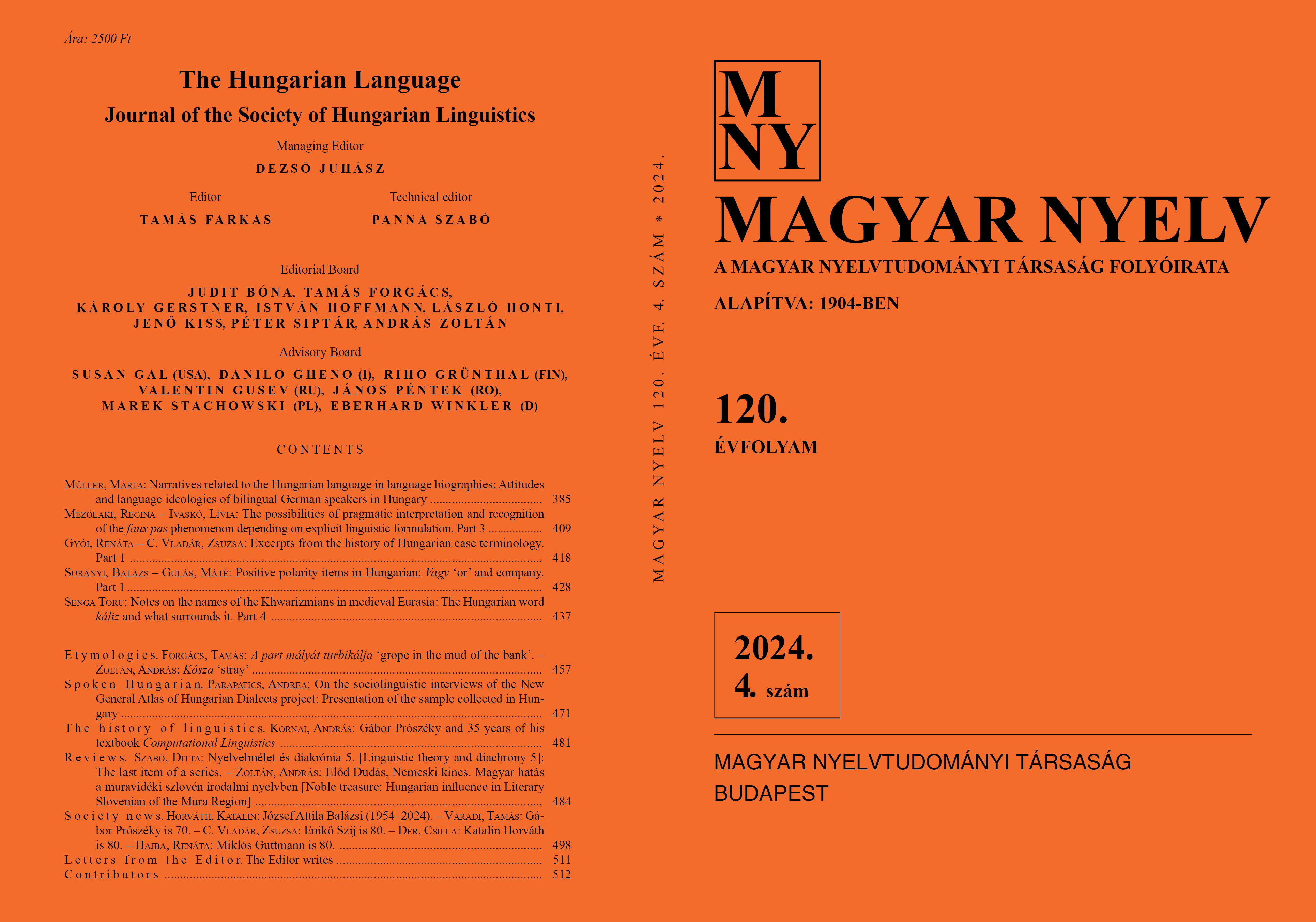Notes on the names of the Khwarizmians in medieval Eurasia: The Hungarian word káliz and what surrounds it
Part 4
DOI:
https://doi.org/10.18349/MagyarNyelv.2024.4.437Keywords:
Khwarizm, Khwarizmians, caliz, Turkic loanwords in HungarianAbstract
For the designation for Khwarizm and the Khwarizmians, there was once a form *χwālis, which was used among speakers of a certain Iranian language and can be traced back to around the middle of the 6th century. The author assumes that the Turkic-speaking peoples – among others the Khazars and the Pechenegs – adapted this word by resolving the consonant cluster in the forms *qālïs and *quwālïs. In the 9th century, Hungarian speakers who lived in the neighbourhood of Kazaria borrowed this word in the phonetic form kāli̮s, which was recorded in an 1111 document with the letters caliz. The forms ḫaliṣ and the ḫuwāliṣ mentioned by Arabic writers in connection with the Khazars and the Pechenegs, respectively, correspond to the Turkic words *qālïs and *quwālïs. The ethnonyms, Χουάληϛ (Notitia Episcopatuum) and Χαλίσιοι (Joannes Kinnamos) may be a Greek rendering of the Turkic *quwālïs and *qālïs forms, respectively. The East Slavic language adapted the form *χwālis from an Iranian language, whose speakers were presumably the Ās people. The name Хвалис does not refer to Khwarizm proper, but was primarily used to designate the Khwarizmians settled on the northern coasts of the Caspian Sea. The activity of the Khwarizmians – mainly in the field of long-distance trade – was not limited to Central and Eastern Europe, but spread all the way to China. The Chinese renderings of their name in the mid-eighth century reflect the Iranian (supposedly Sogdian) form, but among them there is also a Turkic form, Guoli 過利 (˂ *qālïs).
Downloads
Published
Issue
Section
License
Copyright (c) 2024 Toru Senga

This work is licensed under a Creative Commons Attribution-NonCommercial-NoDerivatives 4.0 International License.
Magyar Nyelv is a Diamond Open Access periodical. Documents can be freely downloaded and duplicated in an electronic format, and can be used unchanged and with due reference to the original source. Such use must not serve commercial purposes. In the case of any form of dissemination and use, Hungarian Copyright Act LXXVI/1999 and related laws are to be observed. The electronic version of the journal is subject to the regulations of CC BY-NC-ND (Creative Commons – Attribution-NonCommercial-NoDerivatives).
The journal permits its authors, at no cost and without any temporal limitation, to make pre-print copies of their manuscripts publicly available via email or in their own homepage or that of their institution, or in either closed or free-for-all repositories of their institutions/universities, or other non-profit websites, in the form accepted by the journal editor for publication and even containing amendments on the basis of reviewers’ comments. When the authors publicize their papers in this manner, they have to warn their readers that the manuscript at hand is not the final published version of the work. Once the paper has been published in a printed or online form, the authors are allowed (and advised) to use that (post-print) version for the above purposes. In that case, they have to indicate the exact location and other data of the journal publication. The authors retain the copyright of their papers; however, in the case of an occasional secondary publication, the bibliographical data of the first publication have to be included.



